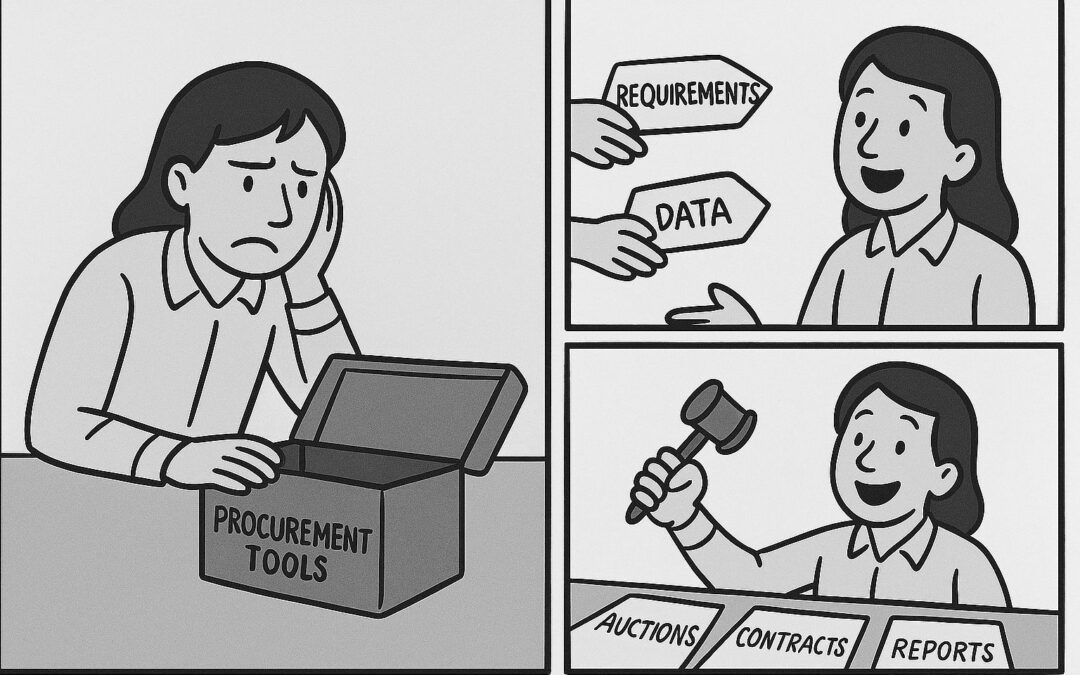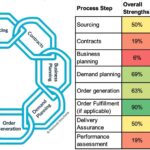We Can’t Do The Things Without the Stuff
“We can’t do the things without the stuff!” she exclaimed during our daily check-in call. She was waiting for the technical team to send final specifications so she could finish building the e-auction. I’m not sure why it resonated with me so strongly, except this statement is at the core of procurement and even supply chain: We can’t do the things without the stuff. Until the stakeholders tell us what they need, when they need it, and how they need it, we can’t move forward. So today’s article is about the stuff we need (to do the things), the things we can do with the stuff, and how we can work with stakeholders to get the stuff and do the things.
The Stuff We Need
Every department of every company has things they need to move forward, whether those things come from internal or external stakeholders. The supply chain team is one of the few departments with roughly equal numbers of internal stakeholders (other departments, technical teams) and external stakeholders (suppliers). The other department that is as balanced between internal and external is sales, on the “other end” of the business cycle from procurement. While it’s intuitive to many of us in the supply chain, it’s helpful to actually list out what we need from our stakeholders:
- Scope of work requirements. Per my article on writing a good scope of work, we need to know what our internal stakeholders need in addition to how much, when, and where it is needed. It might be helpful to know why it’s needed, but that’s also part of a larger picture and might be optional depending on the category.
- Supplier Lists. This means a list of suppliers (and maybe vendors too) with existing company relationships. I put this on the list because some suppliers are very good at building relationships with technical teams and the procurement team might barely know what those suppliers sell. The procurement team needs to know who these suppliers are and what they offer.
- Bid criteria. The supply chain team can do very little without knowing what “good” is and how the technical teams define value. It makes no sense to chase every last penny out of a supplier price when the technical team only cares about lead time. The supply chain team (and supplier for that matter) has to know what criteria are most important for each purchase.
- Forecast/demand/timing. Originally I made this a couple of categories (forecast/demand and timing), but they are ultimately a part of the whole. A supply chain team needs to know when stakeholders need something as well as when a supplier can deliver things to be successful. This is a little wrapped up in the scope of work (when is the good or service needed) and even the bid criteria (maximum acceptable lead time), but it’s ultimately a little different. The demand forecast is the cadence of timing, how often something is needed, and how that need affects other timelines in the company. A supply chain team has to have information on the flow of goods and services into and through the business to ensure value through tools like blanket orders.
- Alternatives. One interesting source of value is in alternatives to the original request. This might mean the technical team has multiple results that would be acceptable (i.e. either of these two pumps will meet spec) or it might mean the supplier has alternative options to offer (i.e. this newly developed pump would also meet your need at a more attractive price point). The supply chain team needs to know when alternatives are acceptable, and what types of alternatives might be approved.
- Bid responses/quotes. This one comes from the external stakeholder side. The supply chain team needs engagement, responses, and quotes from suppliers. Increasingly, it seems like “ghosting” is more and more common in all aspects of business (where someone simply stops responding and disappears without a trace or explanation), and it’s happening even in sales. At the very least, the supply chain team needs to know why a supplier won’t bid on a requested quote. Is it beyond current capacity? Doesn’t fit their core competency? Or is it even a Request For Proposal (RFP) that was poorly written and therefore unappealing?
- Data. Data is tricky because there is a world of difference between clean data, reasonably clean data, and messy data. The world hasn’t really settled on how clean data needs to be for AI automation and other functions, but I’m seeing that it needs to be at least 80% clean for AI to work. That being said, a supply chain team can often clean up the data they need as long as they have access to it. I have a current client where no one in the supply chain team has access to the company’s invoices. Whether that data is messy or clean, they cannot run a full spend analysis without at least having access to that data. Data also includes external data on markets, category indices, and risk factors.
Things We Can Do With The Stuff
In a perfect world, we now have the stuff! I’ve done this a little out of order according to Simon Sinek (start with why!), but next let’s talk about the awesome things a supply chain team can do with all this great stuff.
- Build bids and e-auctions. With a good scope and a supplier list, the supply chain team can go to market and find the best solution. At many smaller companies or those with a less mature supply chain, people across the organization are doing procurement work. If there’s no supply chain or procurement department, that’s probably ok. The earlier you can hand procurement work to a professional the better. Everyone “buys stuff” in their daily lives. But a procurement professional improves cost, reduces risk, considers multiple factors, builds supplier relationships, and just generally adds value. It’s a little bit as if you treated every purchase as if you were buying a new car for your family, and it’s more than just “buying stuff.”
- Improve supplier relationships. One of the primary things a good supply chain professional does is interface with suppliers. A great supply chain professional then builds and strengthens relationships between a company and its key suppliers, using the supplier list and bid criteria as well as all the other information they juggle. Good supplier relationships lead to better pricing, less risk, and more options for the technical teams.
- Go get more value. If the supply chain team knows the details of what is needed, the cadence of production, and has good data, they can go chase some of the non-monetary value items that make a company better. This might mean more face-to-face meetings with the HR benefits supplier or exclusive branding that makes a company’s products stand out in the market.
- Ensure the buy meets the need. This one is tricky and I often use it to differentiate a good procurement professional from a great one. A good procurement professional gets their internal stakeholder what they asked for at the right price, time, and quality. A great procurement professional reads between the lines to meet that stakeholder’s true and long-term need, which is often different from what they requested. This requires a deep understanding of the stakeholder, the business, and the category involved and takes time and experience to build.
- Time the market (as well as possible). No one has a crystal ball. But with good data and expertise, a supply chain expert can do better at timing the market. This market timing helps purchase items at good prices, with good timing, and at reduced risk (do you sense a theme yet?).
- Automate processes and implement AI tools. Supply chain is an excellent opportunity for AI to remove busywork and allow more value-added activity. Simply converting requisitions to POs all day does not add much value and is easily done by AI tools. Instead those professionals, given the right inputs, can automate the task and work on building bids, improving supplier relationships, and digging into a stakeholder’s true need.
- Analyze Data. Give me a giant spreadsheet full of PO line data and four uninterrupted hours any day and I will be completely happy. (If this isn’t your thing, there’s a guide to a quick and dirty spend analysis here). Data lovers like me can be found in every supply chain and can turn all that data into actionable insights. This means the data can inform which suppliers to move business toward or from, the resources needed to run your supply chain, and a myriad of other information bits. Without the data, none of this is possible.
How We Get The Stuff
This is where procurement and supply chain roles get challenging. We know we need the stuff (to do the things!). We know what things we can do when we get the stuff. But how do we go about making these connections and getting what we need? Our internal and external stakeholders have their own worries and likely don’t have time to make supply chain needs a priority. Here are some thoughts on how you can get what you need to succeed and add value to your business.
- Build internal stakeholder relationships. You need strong relationships, especially with internal stakeholders. This means learning to speak their language without expecting them to learn yours. They don’t need to care about the difference between an RFP and an RFQ or the exact process to convert a requisition to a PO. Strong relationships mean attending their staff meetings, but remembering it’s their meeting, not yours. Building that relationship means treating internal stakeholders like customers and being their ally in their battles with the outside world.
- Show value. I’ve talked about value a lot in this article because it’s important. We have to do more than buy stuff, chase savings, and lecture the company CFO on procurement policy. Value is about finding the non-monetary extras that matter and keeping the whole iron triangle in mind. It also means understanding how your work affects the company bottom line. This last one has the bonus effect of being able to articulate the value you bring, which will help your career and team as well as the company.
- Understand the organization. Know who and what drives your business. Is it the engineering team? Sales team? Which team has the real power in your organization outside of the c-suite and why? What makes your company more valuable to customers or clients than your competitors? How is your brand perceived? How does it want to be perceived (if perception and reality are different, and they usually are)? What causes your leadership team to wake up in a cold sweat in the middle of the night? I’ve met plenty of front-line supply chain professionals who yawn through company quarterly reviews (or skip them!) because they don’t see the connection to their day-to-day jobs. I argue that the quarterly review (yes, it’s super boring. I agree.) is incredibly important to the supply chain team. The supply chain is one of the few teams that really touches everyone in a business. It’s very hard to argue your value when the things you prioritize don’t match business priorities.
Now that we’ve talked through what we (as supply chain professionals) need, what we can do when we get it, and how we can go about getting it, go forth and get value. After all, we can’t do the things without the stuff.
If you would like to talk about your own challenges with “things” and “stuff,” let’s chat. If you’d like to get these articles weekly straight to your inbox and never miss one, sign up for my newsletter.
My book, Transform Procurement: The Value of E-auctions is now available in ebook, paperback and even hardcover format: https://www.amazon.com/dp/B0F79T6F25




